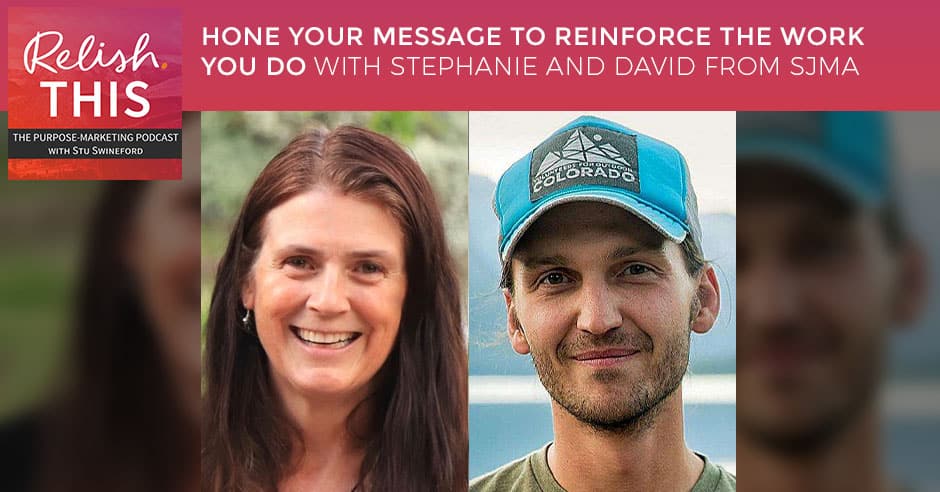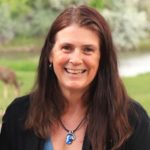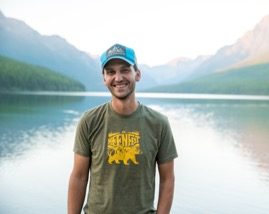
As you’re probably aware, I’m a big fan of protecting Colorado’s open spaces. You may know Relish is involved with 1% for the Planet, but I think it’s also of interest that I’ve chosen to live deep in the forest of Colorado’s Front Range. It’s fair to say environmental stewardship is engrained in what I do.
That’s why this episode of Relish This was so much fun.
I got to chat with two people—Stephanie Weber and David Taft—who work with the San Juan Mountains Association.
The organization was started in the Durango area, and since their inception, they’ve expanded their reach. Now they preserve and protect forests with a solid ambassador program, education program, and volunteer program. All of these initiatives help people who are enjoying the forests understand the importance of protecting these pristine locations.
SJMA now impacts more than half of Colorado’s wilderness areas!
This episode focused on helping SJMA hone their message and expand their reach and engagement with stakeholders. Through social media, email, and general community networking, we look at strategies and ways to answer the question, “How do you reinforce all the good you are doing?”
This was a fun conversation with a group doing some real good for Colorado’s public lands and forests. I hope you enjoy the show.
—
Link:
Action ask: Get involved in your own backyard to protect public lands.
—
Listen to the podcast here:
Hone Your Message To Reinforce The Work You Do With Stephanie And David From SJMA
This episode features two great people from San Juan Mountains Association. They are doing some great work touching over half of Colorado’s wilderness forest areas with their influence and benefit. They have this great organization down in the Durango area that started as a focus on the San Juan Mountains and the forest down there to help preserve and protect a lot of that area from use. They have a cool educational program, ambassador program, volunteers and donors. They are doing some fantastic stuff.
We talked a lot about ways that they can help hone that message, show up more effectively to people who know them and expand their reach through social media and email. There are some good gold nuggets of information that we were able to unearth. This is a fantastic episode. I’m excited to share it with you and I hope you have a great time reading it. Have a good one.
—
Stephanie and David, how are you doing?
We’re doing great.
Thank you both so much for joining me on the show. I’m excited to learn a lot more about your organization and what you guys are doing there at San Juan Mountains Association. You’re both in the Durango area. Is that correct?
We are, yes.
Is San Juan Mountains Association headquartered in Durango?
Our offices are based out of the public land center, which is the home base for the San Juan National Forest. At this point, we have staff spread from Monte Vista over to the furthest West and up to Montrose. We’re looking for a new staff person in the town of Norwood as part of the Norwood District for the Grand Mesa Uncompahgre and Gunnison National Forests.
I was fortunate enough to do some work on Grizzly Peak Trailhead with the Volunteers for Outdoor Colorado, which is over in your zone by Lake City. It’s a gorgeous part of the state. It’s one of my favorite places to be. I grew up in Gunnison. I have been fortunate to spend a little bit of time in the San Juan’s down there. It’s an amazing country. I commend you for all the work that you’re doing to help preserve things. Tell us all a little bit more about what you do there at your organization and how you’re helping to protect those forest lands and public spaces.
San Juan Mountains Association was born out of a community effort to be more involved in caring for public lands. A lot of that started out with the idea of conservation education and providing visitor information. A lot of the folks who are on SJMA staff are front desk folks in public land offices. We started with the San Juan National Forest here in Durango and we also have folks in Dolores and Pagosa Springs. We have been expanding our partnerships with other forests and with the BLM as well.
Another component of that is with our conservation education. SJMA merged with Durango Nature Studies right before everything shut down due to COVID-19 in 2020. That strengthened both organizations’ environmental education efforts. We start young. We start with preschoolers and kindergarteners through elementary, middle school and high school, believing that when we are exposed to the natural world, we learn to understand it.
From that understanding comes appreciation and from that appreciation comes the desire to protect it. That sums up a philosophy that carries through everything that we’re doing with San Juan Mountains Association. The area where we have grown is in some of the stewardship efforts and Dave, being the Conservation Director, can speak to that in much more detail.
SJMA started their stewardship and field conservation programs through the volunteer program, primarily through the San Juan National Forest but also working with the BLM and the Canyon of the Ancients National Monument. That also expanded beyond San Juan to the Rio Grande over time. Our flagship volunteer program is our Volunteer Ranger Program, which started as our Wilderness Information Specialists, in which volunteers would suit up in a forest service uniform.

They would go through our extensive training, learning about not only forest service policies and regulations but also getting schooled in the Leave No Trace principles. That’s the main route of the program. We’re sharing and spreading a way of doing things on our public land that protects values and ensures that they are available for future generations.
Beyond that, we do a handful of group stewardship projects every year and National Public Lands Day projects. It will be trail work or campsite clean-up. Going from there, we moved beyond the volunteer stewardship programs to manage several crews. We took on the Wilderness Monitoring Program for the San Juan National Forest for the Weminuche and South San Juan Wilderness.
We had a crew of four for a lot of years. We bumped it up to six. That crew, they do not only the wilderness monitoring, which is setting the baseline for the wildernesses but also doing trail work, public contact and all that important boots-on-the-ground work that needs to happen if we’re going to effectively monitor these spaces.
2021 is our first year with our Forest Ambassador Program. That’s more aimed at your front-country visitors. It’s very heavily focused on information, education and establishing that land management presence at some of the busiest trails on San Juan. We have about ten ambassadors working over the course of the season, doing that day-to-day public outreach, educating the public and ensuring that people that visit the forest are doing a good job of visiting respectfully, having a great time and knowing how they can enjoy these spaces in a sustainable way.
You guys have a lot on your plate. That’s a whole bunch of different areas of focus there in terms of outreach or tools in hands. It must be very daunting seeing how many more people are visiting our forests. There’s an increase in the overall impact. What are some of the biggest challenges you have been facing over the past several years in terms of being able to expand your mission or at least keep up with the additional visitors?
I can jump in here since I have got a few years with the organization under my belt. In terms of rising to the challenge of helping manage the additional visitation, we have done a lot of work establishing new partnerships and roles within the land management agencies that we work with. That has led to some productive outcomes as far as raising funds and adding additional programs that are supported by whether it’s the agencies or private interest foundations. It has been a challenge keeping up with the staffing and ensuring that we’re keeping our administrative fortitude on par with those additional staff and programs. That has been something that we have been working hard to make sure that all the nuts and bolts are in place and keeping the wheels on.
Is that mostly a revenue challenge or do you guys see both? It all comes down to that. Being able to get that message out there, has that been part of that hurdle?
It is both. I came in as the Executive Director on May 1st, 2021. The organization has grown so considerably. When I came on May 1st, 2021, we had fifteen folks on the payroll. By the end of May 2021, we were approaching 40 and we peaked for the summer at 45. Most of those by design are seasonal employees. We will be contracting and we are contracting now. The idea in our efforts is we recognize that the demand for public lands and recreation on public lands isn’t expected to drop anytime soon. How do we sustain the staffing that we have had in 2021 and be good partners with our public land agencies? Sustained funding is very much part of that equation.
When we are exposed to the natural world, we learn to understand it. From that understanding comes appreciation and from that appreciation comes the desire to protect it.
Also, the ability to clearly message what our successes have been and how big our role is, it’s a tough one to get across effectively. We all know that we all have very short attention spans these days. To share with people the magnitude of impact that we have had is tough unless you start dialing in visuals, infographics and sound bites to the point where people can absorb the information. For us to say we have 45 staff is pretty meaningless.
For us to say we have partnership agreements with a national forest that covers half of the state’s national forest acreage, that’s a pretty impressive number. There are 11.4 million acres of national forest in Colorado and SJMA has agreements with agencies covering 5.7 of those million acres. Learning how to frame information in a way that can make people go well has been something we’re working hard to do.
That’s a challenge. Nonprofits and for-profit organizations alike are constantly trying to figure out how to reframe that differentiation and how to create a value proposition that resonates. You’re not alone in exploring ways to retool or expand the ways that your messaging can positively impact your ability to connect with people. A lot of times, we look at your differentiation as a challenge of trying to get people to understand why you do what you do matters.
From a nonprofit perspective, that can be a little bit of a head-scratcher as you attempt to position yourselves in the position where the donors or constituents become the heroes of the story. You simply take a back seat to that and help guide them to being able to see themselves in that light. Positioning themselves as that key hero in what’s going on is a real challenge. A lot of times, we try to think of it in terms of a seven-second hook that gets to the answers to three questions, “Who is this for? How does it make their life better? How do they get it?”
In the nonprofit space, that becomes a little bit of a challenge because the beneficiary isn’t necessarily the donor at the end of the day. Figuring out how to frame that in a way that makes the donor or volunteer understand where they reside in the story that you’re trying to tell can be super effective in how you start to craft those stories on pretty much every page of your site and everything that goes out.
I love the phrase, “How do our donors and volunteers become heroes of our story?” That’s great.
It can also become a fun challenge. It’s telling that same story from a slightly shifted perspective. It’s coming at things from that way where, even if you’re highlighting volunteers, creating opportunities for case studies that reframe that narrative is pretty important. One of the things we see with nonprofit organizations is there’s always friction in terms of people’s desire to take some action. In the for-profit space, that’s usually buying something or signing on for a service.
In the nonprofit space, there’s an amplification of that friction. There are multiple frictions that people bump up against as they are going through that journey. Most of us don’t wake up in the mornings thinking, “How can I give away some of my money or time today?” We’re much more strongly motivated by things that we get as opposed to things that we give. If you can fine-tune and get that story dialed in where it eases that friction, people are taking this uphill journey in terms of wanting to participate or give away some of their hard earned time and money. Creating opportunities to reduce that friction all along that process is key.
I love your thoughts on how we navigate and message with a lot of folks who are moving here from out of state. For many, this is a silver lining to COVID, the ability to live where you want to live because you can work remotely. In an area like ours, we have seen tremendous growth. Lots of folks from out of state or other parts of this state are coming here simply because the San Juan’s are gorgeous. Why not live where they can easily go play? We’re messaging to some of those folks coming in to say, “You’re moving here to take advantage of the things we’re trying to protect. Be a partner.” I would love your thoughts on that.

It’s a clear value proposition. What most of the people that are moving here recognize is it is the key motivator, ensuring that there’s effective communication. To clearly iterate that is an effective and potentially important facet of our communication.
There’s that educational component that comes into play where people may have done things a bit differently where they came from or they may not understand the effects. I’m thinking about off-trail travel above treeline, which is a little bit of a tongue twister there. People don’t understand all of those impacts when you have such a short growing season and how simply walking off the trail can create a negative impact on the vegetation in those areas.
It comes down to education, which comes down to an awareness that there’s a problem. That can be the first step. How are you guys doing that now? All of these programs are designed to do that. When you’re covering 5 million acres of forest with several thousand trailheads probably, what are some of the techniques that you have been using to get that message out there?
I would love to say we have some effective forest ambassadors. They are, but they are limited to the San Juan National Forest, not GMUG or the Rio Grande. It’s a challenge to be sure. Leave No Trace is pretty much part of everything we do with the visitor information. We mentioned the folks at front desks of public land agencies are very well-versed in Leave No Trace principles recreating responsibly. The forest ambassadors and our wilderness crews are instrumental in that. That is a small part of what is needed but the part that we are playing in partnership with our federal land managers.
It’s a big challenge to get in front of many people that are dispersed. David, can you speak more about some of the educational programs that you have put in place?
I have mentioned that the main thrust is the outreach by our staff, ambassadors, wilderness crew and volunteers. We try to make sure that each of those receives pretty regular training and updates as far as messaging. The main gist of it is to get our staff and volunteers in a room so that we can practice and become more familiar with the messaging that we’re trying to convey. We do focus those efforts pretty heavily on the best bang for your buck areas.
Everybody who has ever been to San Juan is aware of Ice Lake, Chicago Basin and the fourteeners down there. We put a lot of emphasis on those couple of zones while COVID has put a brief damper on it. What we like doing is setting up a little base camp where we can base both our staff and volunteers right in the meat of it. Right in Chicago Basin at the base of the three fourteeners and then right at the base of the Ice Lakes Trailhead, it’s our two primary spots that we like to put the heaviest emphasis on our outreach and education.
A big part of it is always getting our volunteers and staff comfortable enough with the messaging that regardless of who comes at them, they are going to be comfortable engaging in that conversation. To do that, we try to make sure they get plenty of face time with agency partners who we think are the best source in a lot of ways for getting our educational messaging nice and tight.
We teach them all how to do trail work so that they can grab a tool and head out in their uniforms. That gets people chatting with them easily. Everybody wants to talk to the person that’s out clearing a drain or building a little rock stair because those are the people that it’s so easy to open up with. That’s always been my first choice when it comes to how we are going to create an easy setting for which people to engage with our staff and get that educational message out.
The folks at front desks of public land agencies are well versed in leave no trace principles, recreating responsibly, and the forest ambassadors and our wilderness crews are instrumental in that.
One of the things I love about your site is that it does have information about some of these places. Maybe they want to go on the Alpine Loop or something. There’s information there about that adventure. There’s a good opportunity for your site to show up in terms of being available as a resource for people to get trip planning information. On top of that, there’s the impact in the stewardship component.
One of the things that a lot of nonprofits have a little bit of a challenge with is asking for people to help out with some things that are a little less traditional. Volunteering or donating tend to be things that nonprofits and their teams get pretty familiar with being able to ask. Even sharing a tip, message or a piece of information would help get to a different audience.
One of the things that social media has done is it allows us to be pretty well connected, but it has created a situation where we’re starting to get more boxed into our own little groups. The social media channels tend to show you information that is aligned with other information that you have liked, shared or have even read.
I’m thinking about out-of-state people. They may never even get this information put in front of them. There might be an opportunity to create little business cards or little tips that people could share on their own social media accounts to get that stewardship stuff out into a different audience than it might normally be shared with. That might be an additional ask that you make of your volunteers, ambassadors and everybody else.
It’s a familiar concept. I worked at Volunteers for Outdoor Colorado back in 2015. That year, they kicked off an app. It was the Stepping Up Stewardship app or something along those lines. Part of that was sharing. That’s a good way to amplify the message and potentially hit some audience that we wouldn’t otherwise get in front of.
My business built the Stepping Up Stewardship site for VOC back in the day. It is more tooled toward other trail-building organizations. They are trying to share their volunteer coordination and trail-building and intellectual protocol with other trail-building organizations. There was also a phone app that the VOC had that was more tips and things like that.
I know Leave No Trace does a pretty good job of this with some of the cards that they hand out that you can carry with you or put on your backpack with a little carabiner that gives out those tips. It’s any of those things that people can feel like it would be interesting or cool to share that they could get along the way, like having your ambassadors offer to take pictures with people if they share it on social media. Little things like that get that message out there, particularly to a more diverse group, would be some of the things that would be beneficial.
In addition to popular hiking trails, we have had a couple of ambassadors stationed along the Alpine Loop, which if you’re familiar, it’s a popular OHV system that goes from North of Silverton, Animas Forks over to Lake City and back around. It has become incredibly busy. In fact, people using Waze or Google routing will often see backups.
It’s not anywhere else on our highways. It’s just on that Alpine Loop, which makes me wonder how fun that can be sitting in traffic, but that’s okay. It’s still beautiful. Our Alpine Loop Ambassadors have done a phenomenal job interacting with, reaching out and connecting with a lot of these OHV-ers, which are frequently from other states and going to backcountry use. It has been phenomenally successful and we’re proud of them.
It’s great to see some signages. I come over Cottonwood Pass on occasion when I go over to Gunnison and there are some good signages there about staying on the trail. They have done a good job of creating OHV byways. I know that’s big in Silverton for sure. Figuring out ways to not only get those people more educated about the impacts and how to keep these areas pristine and still enjoy them but also get them to share that information is the piece that would be interesting. It’s a matter of figuring out what some of those sharable tidbits would be. Ask to see if people will help spread that message out to their networks when they go back to Texas or wherever they may have come up from.

They have been receptive to that. You’re going to find exceptions to every rule. For the most part, they have done a good job of absorbing this data trail message, the Leave No Trace message and sharing that with peers. There’s room for improvement because we need to protect these places for generations to come.
I know that you have also done a good job of diversifying that in terms of being able to purchase maps and things like that through your site. Is it mostly grants? Is it still donations? Where’s the bulk of your revenue coming from?
The bulk of it is from the agreements we have with our federal partners for complete transparency. The next largest piece of the pie would be from grants and our retail outlets. In addition to providing visitor information, we’re also able to sell maps and guidebooks at each of the public land outlets where we operate. There are fourteen of those throughout the Rio Grande, GMUG and San Juan National Forest, so that helps. Donations and memberships still comprised the smallest piece of our pie, but we’re working hard to expand that piece.
The diversification pieces are something that we see a lot of organizations either be nervous about adding or be anxious about how to even do that. It’s great to see that you have expanded a retail component. That’s blown out not just from the website but you do have opportunities for brick and mortar sales as well. In terms of the federal component, which you said is probably one of the bigger revenue drivers for you, are those guaranteed funds? Do you have to fight for them every year? How are those structured?
It’s a little bit of both. The nice thing is we enter into five-year agreements. That’s nice to know we have been with each other for at least five years. The second part of that is, with anybody dealing with any government budget, nothing is guaranteed. We are constantly seeing what they have to allocate in our direction. There’s tremendous variability in what we receive from those agreements. Fortunately, they have been strong supporters and we have done fine.
We would love to have a foundation through an endowment that helps stabilize those fluctuations. We can plan from year-to-year. We were finishing up 2021. We have had somewhere between 20 and 25, depending on who is working part-time and who stepped away for a while. The forest ambassadors and wilderness crew are out in the field at any given time. We’re not sure we can have that number in 2022. It would be nice to have some certainty from year to year as to how many folks we know we can have as land stewards out on the forest.
That’s due to the fluctuation in federal money and grant money donations coming in. I know that there are some fairly large landowners down in your neck of the woods. Do you have a program in place to try to engage with or get in touch with those people? Isn’t it Ralph Lauren or somebody who has a big chunk of land in between Ridgway and a road that goes over to Telluride?
There are people who have some resources that we would love to tap into. Let’s say we are working on a plan. Isn’t that the eternal nonprofit management message? The growth that we have experienced puts us in a position where a lot of this is even conceivable and so much has changed. You have put forth a number of great ideas and suggestions. How to message and broaden the support for what we’re trying to do is very much a part of our work now.
It would be nice to have some certainty from year to year as to how many folks we know we can have as land steward out on the forest.
From what I’m seeing, you’re laying some pretty good groundwork here online. It looks like you’re active on Facebook and Instagram as well. Those are our two social channels that tend to get quite a bit of traction. Unless you want to start playing in trying to capture youth opportunities, at which point you might want to look into some of the more up-and-coming social media platforms like TikTok.
However, that is mostly going to be one of those where they are going to recommend up in terms of, does either desiring to go to these types of places and then asking their parents to take them there or something of that nature. It feels like you’re probably playing into the ponds in terms of social. What are you doing with your email campaigns or email programs? Do you have a pretty robust email list at this point of past donors, volunteers and interested people?
We do. Now that I think about the numbers and then the number of people living in this area, there’s plenty of room for growth. Our email subscription list is about 3,600 folks. The struggle I have and I would love your thoughts on this too, Stu, is we’re all bombarded with so many electronic newsletters. We got at one point this summer where our eNews was fourteen pages long. We’re doing a lot but we have to have it more concise. This is where my biggest struggle is. Facebook and Instagram are doing a pretty good job of messaging the eNews so that it comes to everybody’s inbox. They want to see and scan it. How we get them to absorb it is a struggle I wrestle with constantly.
There are a few things that we have seen work relatively well with email. I don’t know exactly how engaged those 3,600 people are, but that’s a big enough list to make some things happen. There are a few things about email. The first thing is one of the reasons we are still excited about email is that Boomers tend to use email quite a bit and continue to be the largest donor base that’s out there. That generation is there. It’s starting to get older. They want to create opportunities to do some good with some of the money that they may have available. They tend to be a pretty good donor resource, which is why email is still a very viable engagement tool.
A fourteen-page newsletter you have identified is probably not ideal. Sending out something giant and robust like that every once in a while isn’t a bad plan. I will test it if you have that much material. I would put it out there and see what happens. Look at your click rates and open rates. One of the things that we have been both doing internally and recommending for our nonprofit partners is to consider all of your interaction as very value-based and attempting to provide information that’s not just asking for things all the time but it’s providing real, tangible value.
These could be everything from how to camp effectively in bear country, things to do and look for that are perhaps a little bit off the beaten path in terms of side trips off of the Alpine Loop, if that’s an option, places to stay or places to get lunch while you’re on your tour. It’s things that are value-adds that aren’t just about nagging people to stay on the trail, pick up their trash and do all those things that we want them to do.
It’s also narrowing down those emails to a single value-add. Instead of sending out one fourteen-page email, how can we get maybe ten smaller emails out of that so that there’s a very specific thing going on in that email that somebody can learn, share or pass on? It’s even hard to share a newsletter if there are some specific parts of it that you want somebody to dive into. It’s hard for people to share that because it’s embedded in this larger format.

The other thing that I would consider is segmenting your list and asking people what they are interested in, “Are you interested in camping tips, volunteer information or other items that might be in that fourteen-pager?” Send more specific emails to those people based upon their identified interests.
That’s a great idea and we have been looking to do that. Hopefully, now that we’re coming off a pretty intense summer season, we’ll be moving more towards that. That’s a good reminder that we need to head in that direction. I like the idea of value-based messaging. I can see a lot of ways to go with that. Dave, that’s got your brain spinning too.
There are some good potentials that break away because now we are growing as an organization to several different elements. I have heard from volunteers myself that there are certain things that they are really into and certain things that they are lukewarm on. We could have higher engagement by providing that content that keeps them hooked.
It’s all about delivering value, whether that value is that your organization helps protect these open spaces and natural spaces that we all love so much or the value of explaining to people how to build a drain in a trail. Not everyone would need to know that necessarily, but if you had that message sent to the right audience, you would certainly position yourself as well in terms of staying top of mind when they are out looking for an organization to engage with.
You would probably have your volunteer segment and donor segment. You want to ask everybody every once in a while if there’s a volunteer project coming up, if they would be interested in coming out and supporting that, and if they can’t come out, if they would be willing to donate some funds to help buy everyone lunch. If you can frame it in terms of how these efforts are tangibly used to benefit the San Juan’s and beyond, that’s where people will get excited about it.
It’s not just, “I’m donating to this organization. I don’t know exactly what that is going to accomplish.” It’s like when organizations say, “It takes $1 a day to feed and buy books for a student in this zone.” There’s a very tangible outcome to that support. Figuring out ways to message that can be super helpful. David, do you have problems reaching out to new volunteers? Do most of your projects fill up? How is that part of your program working?
In general, we have good volunteer engagement. We have done a fairly good job both of establishing a volunteer base and putting ourselves out in the community in ways that can attract new volunteers as well. In particular, I have noticed an uptick in volunteer interest as we have done a pretty concerted effort of expanding our online efforts, whether that’s social media platforms or emails. Being consistent with it has drawn a lot of interest and then by having folks in the field especially. Having those ambassadors out there, they are constantly referring new volunteers to us. You can’t put a value on good quality human interaction.
One of the facets of being in a small community is it can either be really easy if you know the right person or really difficult if you don’t, just to build relationships.
I’m on the board of a trail-building organization over here in the Nederland area. When we’re out building, people stop and ask us questions and thank us. It’s a huge opportunity to get them more involved by offering to let them know when our next trail-building day is because most people who use the outdoors do feel like there’s an opportunity there to give back and they may not be doing it. There’s this sense of guilt that pops up.
Fortunately, there are ways to alleviate that guilt by volunteering a little bit. It’s letting people know how rewarding it is to hike on a trail that you may have built a little section of, even if it’s just a small section. I’m wondering if there are opportunities to get out into the local hotels, restaurants and even ski areas. You have a couple of pretty amazing ski areas down in that zone with Silverton, Wolf Creek and Purgatory.
A lot of the ski areas are starting to want to educate their users a little bit more than they perhaps have in the past, particularly with climate change. It’s being able to give somebody something to do if they are visiting Purgatory in the winter to go ski and planning to come back in the summer. Putting that bug in their ear that they might be able to donate half a day to building some trail, picking up some trash or doing something that gives back a little bit might be another opportunity to get in front of some of these people.
Those service vacations can do wonders. Another area there that we have had success and also an opportunity to do even more is workplace projects. It’s inviting a corporation or business to do some employee bonding through this project. David had some good examples of success stories there, which we would like to capitalize on further.
You probably have a lot of experience from your time at VOC with that. I know that they have big corporate days and will put together these decent-sized parts of projects that some of these local corporations will come out and put people on.
A big part of the programming at VOC is something that I would like to add here. We have done a bit of engagement with the local business community. It has been nice to build some relationships. It’s helpful for the fundraising side of things as well and having those relationships in place. There are tons of room for growth as far as corporate engagement.
I’m wondering if there might be an opportunity to do roundups with some of the ski areas or dedicate some volunteer time on your pass as you’re buying a pass. There are all sorts of creative ways to try to get people to feel like they have an opportunity to give something back. It doesn’t have to just be time.

It’s great to spend some time outdoors working in nature and doing those types of things, but some people have a little bit more money than they have time. Giving them options is something that can be key in terms of getting engagement and getting people involved. Are there any other things that you have considered that you tried that didn’t work quite as well as you would like or you have been thinking about but don’t know exactly how to pull the trigger on?
I’m going to toss that one to David to see if he has anything because, four months into my tenure, there are still a lot of things ahead on my to-do list and not my, “I have tried this. Let’s figure out plan B.” David, how would you handle it?
One of the things that do come to mind is what we were talking about in terms of establishing the relationships to move forward with some of the corporate engagement. One of the facets of being in a small community is it can either be easy if you know the right person or difficult if you don’t to build that relationship. We have made some progress in various ways. There are some big fish in the community that it would be great if we could figure out what that access point would be, whether it’s a particular type of project or a particular person that holds the keys to that gateway.
I’m going to go back to the rounding-up opportunity. That doesn’t cost the organization much. There’s probably a little bit of accounting work and then a little bit of training in terms of getting their people to start asking for that. At the end of the day, they don’t necessarily have to match anything or do any donation themselves. They are merely asking people if they want to round up to the nearest dollar or even tack on a donation if you give them a line item in their system that is, “Do you want to donate $5 to your organization to the SJMA?”
That creates an opportunity for awareness as well as revenue. Those are some of the things that can be effective. One of our local breweries is called Busey Brews. They had a brew for the whole month of June and a dollar for everyone that was purchased was given back to NATO. They were putting in on that. Every month, they have a different recipient. They instructed their staff to ask if people wanted to round up or make a small donation to our organization during the month of June. It generated revenue and a nice little chunk.
I know that our local Ace Hardware also does roundup days. They give you the opportunity to round up year-round. They will pick a different organization from time to time to be the recipient of that. Every transaction that comes through there, it’s at most $0.99 and at least a penny. If you figure out how many transactions go through, you figure that average is $0.50 on every transaction can start to add up.
Our local Ace Hardware does the same thing. I’m writing notes. David and I will regroup after this for sure to implement some of these great ideas.

I have enjoyed our conversation. I’m very excited to see what happens next or what comes next for you. You’re doing a lot of great work down there in a huge swath of land that I don’t get down to as much as I would like to. I come to Silverton once a year and travel through that zone as much as I can. How can people find out more about the SJMA?
The easiest way is through our website, which is simply SJMA.org. We have got a Facebook and Instagram presence. Both of those, if you search San Juan Mountains Association, should pop up pretty readily. What else am I missing, David?
Those are going to be the easiest three and we’re pretty good about updating all three of them. If you’re feeling particularly excited about the cause, it’s easy to hop on our eNews. If you scroll to the bottom of our webpage, there’s a spot there where you can sign up. Other than that, we also do a monthly column in The Durango Herald if you’re looking for some highlights. That’s called the Stewards of the Land column.
I would also encourage people to make sure that they are looking for your ambassadors and volunteers out on the trailhead during the summer months while they are down exploring the beautiful mountains in the San Juan’s. I love having these conversations, but I also like to spur action in trying to get people to do something after reading our show. If there was anything that you, Stephanie or David, would want people to do after reading, what would that be?
I’ll throw a little plug here. We have got a National Public Lands Day event in conjunction with the BLM office over on the Dolores River. You can find details for that on our website.
Since it is National Public Lands Day and hopefully, many of your readers are spread across the nation, figure out how to get involved in your own backyard to protect public lands or some of your favorite places. We all know it does take many hands to take care of even the wild places. Get involved wherever you may be. If you’re in our neck of the woods, we would love to have you volunteer or be a member or otherwise engage with us.
I appreciate both of those ideas. The more that we can get people out and about enjoying our public lands and then giving a little bit back to them, the better off we’re all going to be. Thank you guys both very much for being on the show. I had a blast talking with you and learning more about San Juan Mountains Association.
Thanks for the opportunity.
Have a great day.
Important Links:
- San Juan Mountains Association
- Volunteers for Outdoor Colorado
- Durango Nature Studies
- Leave No Trace
- Stepping Up Stewardship
- Facebook – San Juan Mountains Association
- Instagram – San Juan Mountains Association
- Busey Brews
- Stewards of the Land
- National Public Lands Day
About Stephanie Weber
 In May 2021, Stephanie Weber became SJMA’s Executive Director. Stephanie is a seasoned non-profit professional who, as the Executive Director of Durango Nature Studies, was instrumental in facilitating SJMA’s merger with Durango Nature Studies. As a Colorado native who lived in Durango during her teenage years, she has deep ties to Southwest Colorado and our public lands. Stephanie returned to Durango in 2017 to lead DNS. She grew up riding horses in the San Juans and now enjoys the mountains on foot or by bike.
In May 2021, Stephanie Weber became SJMA’s Executive Director. Stephanie is a seasoned non-profit professional who, as the Executive Director of Durango Nature Studies, was instrumental in facilitating SJMA’s merger with Durango Nature Studies. As a Colorado native who lived in Durango during her teenage years, she has deep ties to Southwest Colorado and our public lands. Stephanie returned to Durango in 2017 to lead DNS. She grew up riding horses in the San Juans and now enjoys the mountains on foot or by bike.
About David Taft
 David spent his early years in the northeastern US, but his love of the outdoors and the allure of the Rockies brought him to Colorado for college. After finishing his undergraduate at Colorado College, he completed a masters degree in environmental policy at Colorado State University. Throughout his summers in college and grad school, he worked for youth conservation corps around Colorado, and spent free weekends skiing, climbing, camping, and volunteering for conservation organizations.
David spent his early years in the northeastern US, but his love of the outdoors and the allure of the Rockies brought him to Colorado for college. After finishing his undergraduate at Colorado College, he completed a masters degree in environmental policy at Colorado State University. Throughout his summers in college and grad school, he worked for youth conservation corps around Colorado, and spent free weekends skiing, climbing, camping, and volunteering for conservation organizations.
Prior to joining the SJMA, David directed the Adventure Education program at the Canyon Country Discovery Center in Monticello, Utah. During his time there he managed outdoor education programs for schools, youth groups, corporate retreats, and adventurous adults alike. As conservation director David will oversee and expand the volunteer stewardship programs for SJMA. In his free time David can be found mountain biking, climbing, skiing, running trails, and paddling the rivers of the Southwest.
